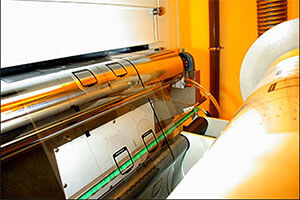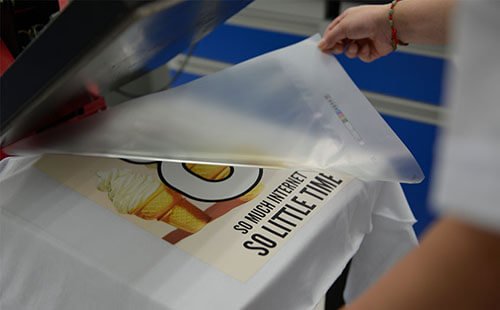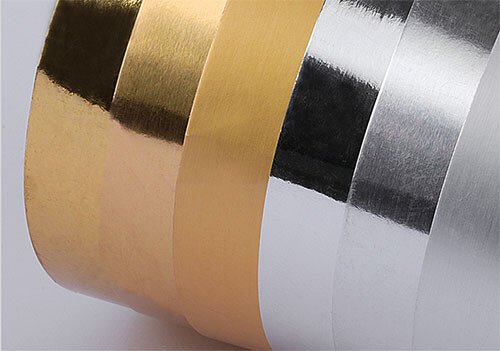What is the application of PET release liner?
2021/07/05

PET release liner is coated with silicone release agent, fluorine release agent or plasma treatment on the surface of PET substrate, so that it has extremely light and stable release force for different pressure-sensitive adhesives. There are the following three categories:
- Release force: light release, medium release, heavy release, the current release force is from 3 g~2000 g.
- Structure: adhesive release film, composite type, laser film, no glue.
- Applications: isolation, protection, waterproof, light reflective, printing, tape release film.
Application of PET release film
1. Transfer Printing
PET film has good heat resistance, strength and rigidity, and is widely used as a carrier for transfer printing. The applicable industries can be divided into two categories.
PET release liner-> printed pattern -> adhesive coating->heat and pressure transfer to porcelain, glass, metal, plastic, cotton fabric, leather and other materials. It has the advantages of good compatibility, low cost, accurate color registration, and green environmental protection.

Release liner->printing ink->adhesive coating->inner plastic injection->Ink and plastic bonding->The release film will be automatically separated from the ink after the mold is opened. IMR products have a metal texture with light weight, good light transmittance, bright colors and high brightness. It is used in large-volume, high-value-added products, such as mobile phones, digital cameras, MP3, mouse, DVD panels and cosmetic boxes.
2. Packaging Materials
PET release film is the carrier film, coat the color layer on the release layer and vacuum aluminize -> coat the aluminized surface with adhesive and composite with other substrates (paper) and dry -> tear off the release film. It can produce cardboard with metallic texture. Its advantages are non-toxic and odorless, and it is suitable for the packaging of high-end cigarettes, food, medicine, alcohol, gifts, daily necessities, cosmetics, etc.

3. Reflective PET
Reflective pet has excellent optical properties, surface flatness, thermal stability and aging resistance. Production process: aluminized PET film -> coating pressure sensitive adhesive -> adhering glass beads with release film -> coating protective layer. reflective pet is used in road traffic signs, vehicle number plates, road cones, textiles, functional fabrics, clothes, shoe materials, etc.
4. Adhesive Tape/Surface Protection Film
Adhesive tape and surface protection film is composed of release liner, adhesive, substrate, suitable for single-sided tape, double-sided tape, label, protective film such as mobile phone, notebook computer display protective film, electronic die-cutting process protective film.
PET Release Liner Requirements
The process of using PET release film must go through evaporation, multiple coating, compounding, and finally peeling. The temperature of the processing process is mostly 120 ° C ~ 150 ° C, and a few moments can reach up to 190 ° C. Therefore, the flatness, cleanliness, and thermal stability of the film are highly required.
| Item | Unit | Requirement | Test Method | |
|---|---|---|---|---|
| Tensile Strength | MPa | ≧150 | ASTM D882 | |
| Elongation at Break | % | ≧70 | ||
| Elastic Modulus | MPa | ≧3500 | ||
| Thermal Shrinkage | MD | % | ≦1.0 | ASTM D1204 |
| TD | % | ≦0.5 | ||
| Transmittance | % | ≧85 | ASTM D1003 | |
| Haze | % | 1.5~10 | ||
| Friction Coefficient | Dynamic | ≦0.45 | ASTM D1894 | |
| Static | ≦0.4 | |||
| Surface Energy | dyn | ≧52 | ASTM D2578 | |
| Surface Resistance | Ω | 108~1011 | ASTM D257 | |
4 Factors That Affect the Release Film
- PET release film is to coat the release agent on the surface of PET. The consistency of substrate thickness and thermal shrinkage directly affect its usability.
- The peel force directly affects the performance of the PET release film, and the general peel force tolerance range is ±15%.
- The optical grade release film is required to be produced in a class 1000 clean workshop, and the PET release film used for electronic die-cutting is required to be produced in a class 10,000 clean room.
- Subsequent adhesion mainly reflects the curing degree of the release agent.
Category
